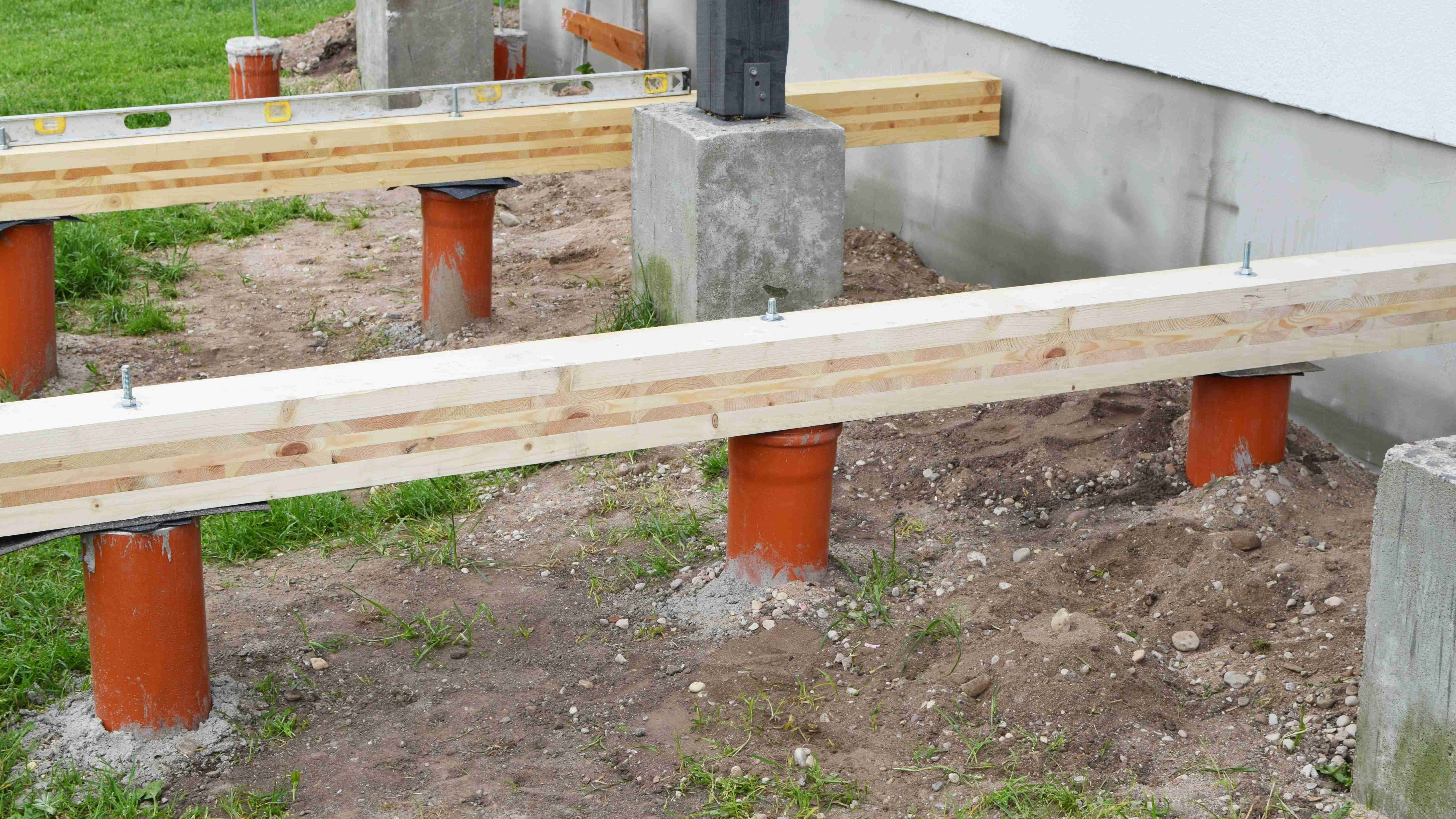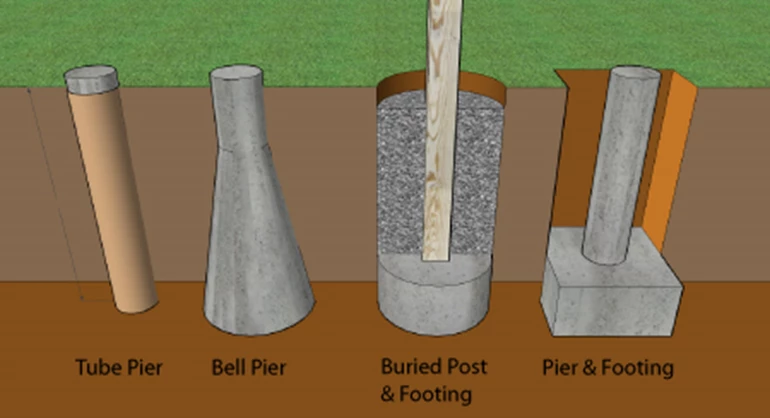Selecting the Right Deck Footings for Stability and Toughness
The longevity and security of your deck depend heavily on the kind of grounds you select, as they supply the important support and security to hold up against the test of time. In this conversation, we will certainly check out the numerous types of deck footings, think about the vital elements to weigh when making a decision, and dig right into the pros and disadvantages of different choices.
Kinds of Deck Footings
These grounds are composed of a round opening filled up with concrete, which offers a strong structure for the deck articles. Concrete pier grounds are fairly simple to set up and supply superb security, making them a preferred selection for lots of deck jobs.
One more sort of footing is the helical pile footing. Helical heaps are steel shafts with helical plates connected to them. These footings are mounted by screwing them right into the ground, which develops a safe and secure structure for the deck. Helical pile grounds are excellent for locations with difficult soil problems, as they can be mounted in virtually any type of type of soil. They additionally enable very easy modification and leveling of the deck if required.
Conversely, some building contractors choose for precast concrete footings. These footings are made of resilient concrete and come in numerous shapes and dimensions to suit various deck designs. Precast concrete grounds are practical to mount and offer a secure base for the deck structure.
Ultimately, one more alternative is the post-in-anchor footing system. This sort of ground involves driving a metal support into the ground and affixing it to the deck message. It offers adaptability in terms of positioning the deck posts and is appropriate for decks with lightweight frameworks.
When selecting the right kind of deck footing, it is necessary to consider aspects such as soil conditions, deck lots, and neighborhood building ordinance (Deck Footings). Consulting with a specialist contractor or architectural designer can help guarantee the appropriate footing is selected for a secure and steady deck
Elements to Take Into Consideration When Choosing Footings
When picking the appropriate footings for a deck, it is essential to meticulously consider different aspects such as dirt problems, deck load, and adherence to local building codes. These aspects play a significant role in guaranteeing the security and sturdiness of the deck framework.
Among the key factors to take into consideration is the soil conditions. The sort of soil on which the deck will be developed figures out the sort of footings called for. For circumstances, decks improved loosened or sandy dirts might call for much deeper grounds to give appropriate assistance and stop settling. On the various other hand, decks developed on clay or large dirts may require footings that can suit the dirt's propensity to broaden and agreement.
An additional important variable is the deck tons. The weight of the deck, including the products made use of and any kind of possible online tons such as furnishings or celebrations, need to be taken into account when picking grounds. The footings have to be created to bear the weight of the deck and disperse it evenly to prevent any kind of architectural issues or failings.
Finally, adherence to regional building regulations is paramount. Building ordinance vary from area to region, and it is vital to abide with the particular requirements established by the local authorities. Deck Footings. These codes make certain that the deck is developed safely and satisfies the necessary requirements for structural stability and load-bearing capability
Concrete Footings: Cons and pros

Concrete grounds supply several advantages and disadvantages when made use of as the structure for a deck. On the favorable side, concrete grounds give excellent stability and toughness.
An additional benefit of concrete grounds is their convenience. They can be put right into various sizes and shapes to suit various deck layouts and configurations. Concrete footings can be tailored to fit the particular needs and demands of the deck structure.
Nonetheless, there are likewise some drawbacks to making use of concrete grounds. This can raise the total expense of the deck project and might need professional help.

Helical Piers Vs. Sonotubes: Which Is Much better?
In taking into consideration the structure alternatives for a deck, the contrast in between helical piers and sonotubes is crucial in determining the superior selection. They are turned right into the ground utilizing hydraulic equipment, giving a secure and long lasting structure for the deck.
The helical plates on the these details piers produce a solid hold with the dirt, shifting or stopping any motion of the deck. Sonotubes, on the other hand, depend entirely on the concrete filling for stability, which might not provide the very same level of stamina and resistance.
In regards to setup, helical piers are reasonably much easier and faster to install compared to sonotubes. The hydraulic equipment used to twist the piers right into the ground guarantees a efficient and fast procedure. Sonotubes, on the other hand, call for digging openings and pouring concrete, which can be lengthy and labor-intensive.
Additionally, useful link helical piers are a more flexible choice. They can be used in numerous dirt conditions and can be changed or enhanced if needed. Sonotubes, on the various other hand, may require extra support, such as rebar, in specific soil conditions or areas with high tons needs.
Picking the Right Footings for Your Deck's Measurements
For optimal structural integrity, it is necessary to thoroughly choose the proper grounds that align with the dimensions of your deck. The dimensions of your deck, including its height, length, and width, play a significant role in determining the type and size of footings required.
When selecting grounds for your deck, it is very important to consider the load-bearing capacity of the soil. The weight of the deck, combined with the weight of any kind of furnishings or individuals on it, puts in a considerable pressure on the footings (Deck Footings). It is essential to choose grounds that can appropriately sustain this weight without sinking or moving over time.
The shapes and size of the grounds ought to also be considered. Bigger decks with better dimensions require bigger footings to provide sufficient security and support. The shape of the grounds, whether they are round or square, depends upon the layout and design of the deck. Furthermore, the deepness at which the footings are installed need to be established based upon the frost line in your area to avoid any heaving or changing due to freezing temperature levels.
Conclusion
In final thought, picking the right deck footings is important for making certain stability and resilience. Factors such as the kind of grounds, the deck's measurements, and the pros and disadvantages of various options ought to be thought about.
These grounds are composed of a round opening filled up with concrete, which gives a strong structure for the deck posts. Concrete pier footings are relatively easy to install and use outstanding security, making them a prominent option for numerous deck jobs.
Precast concrete footings are convenient to read this install and offer a stable base for the deck structure.
It offers adaptability in terms of positioning the deck posts and is appropriate for decks with lightweight structures.
Concrete grounds supply numerous benefits and negative aspects when made use of as the structure for a deck.